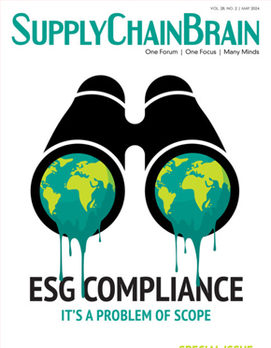
The onslaught of recent events has exposed the vulnerabilities of global supply chains. They create a significant downstream impact, and compound to generate even more risks for businesses.
In such a volatile market, anticipation is the best way to ensure continued success. CEOs must anticipate how physical threats around the globe can trickle down and directly impact the organization. With the right insights and processes, the impact of disruptions can be mitigated. What’s more, they can provide a strategic competitive advantage for companies that are dependent on their supply chains.
Here are three strategies that CEOs should incorporate into their operations to protect against today's biggest threats.
Start from the end and work your way back. Don't underestimate the power of a tabletop exercise. Pinpoint critical links in your supply chain and better understand each process that affects your product, from creation to the moment it’s in your customer's hands. Start at the end of this lifecycle and work your way back. Consider key data such as the location of your suppliers, the product’s journey and its various components, and the people that make it happen.
Make sure you have the right people at the table to assess this — not just from operations, but also logistics, inventory management, shipping, business, sales, customer service and even HR. Once you've created a clear timeline, evaluate each step in the process and rank where the biggest breaking points could be. Having identified current risks that could pose a threat to your supply chain — extreme temperatures, storms, explosions, labor strikes and inflation — consider with the group how these factors could impact the entire workflow, and what would be the best contingency plan.
The right technology could allow your business to be the first to know about threats and activate contingency plans. For example, given the most recent lockdown in China due to the COVID-19 pandemic, businesses worldwide are struggling to find new providers for resources like bathroom fixtures, chemicals for medical purposes, and materials for tech products. Early knowledge of the lockdown would have been key for businesses to switch providers before their competitors, and avoid the bottleneck of organizations trying to mitigate the consequences of the shutdown.
Incorporate artificial intelligence to make sense of all the risk data relevant to your business. In today's world, businesses need to focus on mitigating risk in all forms. Many rely on endless sets of data to make decisions, prioritize activity and pivot accordingly, but raw data can’t create a clear picture of a risk to the business. And it's daunting for any individual or team to keep track of every critical event. Incorporating AI is vital because it helps you make sense of all that data. Without AI, it's not humanly possible to process the volume of data that must be analyzed.
AI can monitor critical events across the globe, sift through irrelevant or duplicate data; verify information pulled from public forums, like social media, and correlate and classify these critical events against an organization's key locations, assets and people. In the process, companies only receive information relevant to their business, and have a clear picture of how and when they need to activate contingency plans. From there, they can analyze the information and determine the next steps.
For example, getting a product into the consumer's hands isn’t a straight line. There’s a myriad of fleets, vendors, manufacturers, distributors, suppliers and other resources that all need to come together to finalize the process. AI can help a business determine which physical threats or world events will disrupt one of these elements associated with operational agility, so that businesses can look for alternative solutions or activate backup plans.
More importantly, the right technology can help a CEO determine when to react to disruptions. Conversely, the wrong reaction at the wrong time, too late or too soon, can create unnecessary costs for a company and result in disastrous financial consequences.
Monitor key factors that could disrupt your supply chain. There’s no manual or step-by-step guide to determining which risks will be the most impactful to your business. However, there are some best practices that CEOs should be in the habit of carrying out as part of their daily risk assessments.
Risks from events like the Russian invasion of Ukraine are easier to prepare for because there was anticipation of the threat. Tensions were rising before the invasion, and circumstances surrounding the impending conflict became world news. However, smaller local events like protests, power outages or violent crimes also impact businesses, and AI can help monitor these smaller incidents that don’t always hit the headlines but have a major impact on your operations. For example, in October, 2021, trucking companies on the West Coast were threatened when ports worked by the International Longshore and Warehouse Union shut down; while those on the East Coast were threatened by the upcoming winter weather. In this scenario, AI registered both threats on opposite sides of the country, but filtered them to only notify trucking companies on each coast about the threat that was relevant to their drivers.
In the case of the Russia-Ukraine conflict, CEOs could have done a quick tabletop exercise to analyze how the invasion would disrupt their supply chains. Even the smallest factors — such as a layover of delivery in the country — could have prompted organizations to look to alternative routes for delivery.
Man-made disasters can be harder to prepare for than natural ones. Even so, the right technology will detect these occurrences around the country the moment they happen, and correlate them with your supply chain's key characteristics, such as the location of your facilities, workers, routes, warehouses, fleets or crops. This information helps businesses determine what impact a threat could have on their most-valued assets and people, enabling guidance on when to activate contingency plans.
Managing risk is essential to keeping ahead of the competition and achieving operational resilience. CEOs face a myriad of risks from current events, large and small. While they know that their supply chains aren’t a straight line, they might not understand the impact that local physical threats could have on their people and operations. They might also not have enough visibility into their supply chains to prepare and activate response plans. By becoming familiar with their supply chains, using existing technology to their advantage, and constantly monitoring risks, CEOs can set themselves up for success in a fragile economy.
Mark Herrington is chief executive officer of OnSolve.







